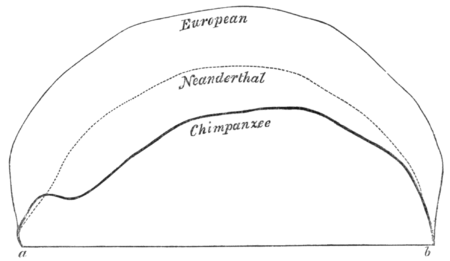extreme breadth, but only measures 3⋅4 inches from the glabello- occipital line to the vertex. The longitudinal arc, measured as above, is 12 inches; the transverse arc cannot be exactly ascertained, in consequence of the absence of the temporal bones, but was probably about the same, and certainly exceeded 1014 inches. The horizontal circumference is 23 inches. This great circumference arises largely from the vast development of the superciliary ridges, which are occupied by great frontal sinuses whose inferior apertures are displayed exceedingly well in one of Dr.
Fig. 4
Outline of the skull of an adult Chimpanzee, of that from the Neanderthal, and of that of a European, drawn to the same absolute size, in order better to exhibit their relative differences. The superciliary region of the Neanderthal skull appears less prominent than in fig. 3, as the contours are all taken along the middle line where the superciliary projection of the Neanderthal skull is least marked,
Fuhlrott's photographs, and form a continuous transverse prominence, somewhat excavated in the middle line, across the lower part of the brows. In consequence of this structure, the forehead appears still lower and more retreating than it really is. To an anatomical eye the posterior part of the skull is even more striking than the anterior. The occipital protuberance occupies the extreme posterior end of the skull when the glabello-occipital line is made horizontal,

